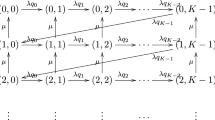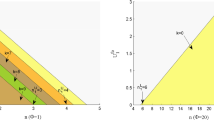Abstract
We study the strategic customer behavior in queueing systems with batch services under incomplete information. In particular, we assume that arriving customers have the opportunity to observe only the number of waiting batches upon arrival and, afterwards, they make their join/balk decisions. We prove that equilibrium strategies always exist within the legitimate class of threshold strategies, but they may not be unique. We also provide an algorithmic scheme for their computation. Moreover, we compare the strategic behavior under this information level with the corresponding behavior in the complete information case.







Similar content being viewed by others
References
Adiri, I., & Yechiali, U. (1974). Optimal priority purchasing and pricing decisions in non-monopoly and monopoly queues. Operations Research, 22, 1051–1066.
Afimeimounga, H. (2011). User optimal policies for a stochastic transportation network. Ph.D. Thesis, University of Auckland.
Afimeimounga, H., Solomon, W., & Ziedins, I. (2005). The Downs–Thomson paradox: Existence, uniqueness and stability of user equilibria. Queueing Systems, 49, 321–334.
Afimeimounga, H., Solomon, W., & Ziedins, I. (2010). User equilibria for a parallel queueing system with state dependent routing. Queueing Systems, 62, 169–193.
Boudali, O., & Economou, A. (2012). Optimal and equilibrium balking strategies in the single server Markovian queue with catastrophes. European Journal of Operational Research, 218, 708–715.
Boudali, O., & Economou, A. (2013). The effect of catastrophes on the strategic customer behavior in queueing systems. Naval Research Logistics, 60, 571–587.
Bountali, O., & Economou, A. (2017). Equilibrium joining strategies in batch service queueing systems. European Journal of Operational Research, 260, 1142–1151.
Burnetas, A., & Economou, A. (2007). Equilibrium customer strategies in a single server Markovian queue with setup times. Queueing Systems, 56, 213–228.
Calvert, B. (1997). The Downs–Thomson effect in a Markov process. Probability in the Engineering and Informational Sciences, 11, 327–340.
Chen, Y., Holmes, M., & Ziedins, I. (2012). Monotonicity properties of user equilibrium policies for parallel batch systems. Queueing Systems, 70, 81–103.
Economou, A., & Kanta, S. (2008a). Optimal balking strategies and pricing for the single server Markovian queue with compartmented waiting space. Queueing Systems, 59, 237–269.
Economou, A., & Kanta, S. (2008b). Equilibrium balking strategies in the observable single-server queue with breakdowns and repairs. Operations Research Letters, 36, 696–699.
Economou, A., & Manou, A. (2013). Equilibrium balking strategies for a clearing queueing system in alternating environment. Annals of Operations Research, 208, 489–514.
Edelson, N. M., & Hildebrand, K. (1975). Congestion tolls for Poisson queueing processes. Econometrica, 43, 81–92.
Guo, P., & Zipkin, P. (2007). Analysis and comparison of queues with different levels of delay information. Management Science, 53, 962–970.
Guo, P., & Zipkin, P. (2009). The effects of the availability of waiting-time information on a balking queue. European Journal of Operational Research, 198, 199–209.
Hassin, R. (2016). Rational queueing. Boca Raton: CRC Press, Taylor and Francis Group.
Hassin, R., & Haviv, M. (1997). Equilibrium thresholds strategies: The case of queues with priorities. Operations Research, 45, 966–973.
Hassin, R., & Haviv, M. (2003). To queue or not to queue: Equilibrium behavior in queueing systems. Boston: Kluwer Academic Publishers.
Latouche, G., & Ramaswami, V. (1999). Introduction to matrix analytic methods in stochastic modeling. Philadelphia: SIAM-ASA.
Manou, A., Economou, A., & Karaesmen, F. (2014). Strategic customers in a transportation station: When is it optimal to wait? Operations Research, 62, 910–925.
Naor, P. (1969). The regulation of queue size by levying tolls. Econometrica, 37, 15–24.
Pai, H.-M., & Cheng, W.-H. (2012). User optimal policy for a parallel queueing system with state dependent routing under the \(M/M^{(N)}/K\) batch service. Preprint available at https://www.ntpu.edu.tw/stat/chinese/journal/journal-1-14-3.pdf.
Stidham, S, Jr. (2009). Optimal design of queueing systems. Boca Raton: CRC Press, Taylor and Francis Group.
Author information
Authors and Affiliations
Corresponding author
Rights and permissions
About this article
Cite this article
Bountali, O., Economou, A. Equilibrium threshold joining strategies in partially observable batch service queueing systems. Ann Oper Res 277, 231–253 (2019). https://doi.org/10.1007/s10479-017-2630-0
Published:
Issue Date:
DOI: https://doi.org/10.1007/s10479-017-2630-0




